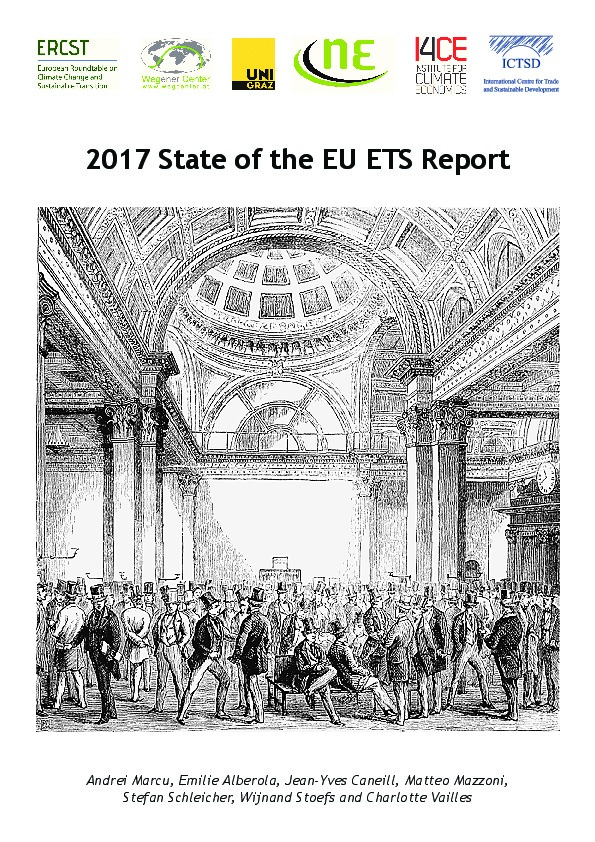The 2017 “State of the EU ETS” report
I4CE has published the 2017 “State of the EU ETS” report, in partnership with the ISCST/ERCST, the University of Graz and Nomisma Energia.
The EU Emissions Trading System (EU ETS) celebrates its 12th anniversary. As any other undertaking, it requires, periodically, an assessment regarding its well functioning, and the delivery of its objectives. The State of the EU ETS Report aims to be an independent contribution to the policy debate, which is needed to ensure that the EU ETS is “fit for purpose.” This report discusses the current state of play in the EU ETS while abstaining, to the extent possible, from providing solutions.
Authors: Andrei Marcu and Wijnand Stoefs , Emilie Alberola and Charlotte Vailles, Jean-Yves Caneill, Matteo Mazzoni, Stefan Schleicher,
Key messages:
- Review: It is important that, in addition to the regulatory requirements, it be subjected to a thorough and independent review, to discover if it delivers on explicit, as well as what have become “expected” objectives, as well as discover any issues that need to be better understood.
- Data transparency: While a significant amount of ETS data is accessible, and it is understood that there are strict confidentiality provisions for commercial data, the issue of availability of public data has been identified as an issue, especially that of aligning reporting of EU ETS and NACE data.
- Governance: the governance of the EU ETS, defined as to “who makes decisions” and “how decisions are made” in order to ensure a stable and predictable regulatory framework, resulting in long-term price signal for investment, is critical. Yet, it is hardly discussed, and little understood.
- EU ETS short-term target achieved with mid to long-term certainty by 2050: There is no doubt that the EU ETS is delivering on short-term environmental targets. For the mid-to-long term, it does not seem to be on the pathway outlined in the Paris Agreement and the EU 2050 Roadmap. The expected post-2020 Linear Reduction Factor, 2.2%, is not putting the EU on a trajectory to reach -90% in ETS sectors by 2050. In addition, EU ETS governance does not, so far, contain governance provisions to align it with the review process of the Paris Agreement.
- The minor role of the EU ETS in the decarbonisation: So far, the EU ETS has not played a major role in driving decarbonisation through its price signal alone. The false expectation was created that the EU ETS price would be able to act alone. EUA prices are making a certain level of contribution to decarbonisation, depending on the level of EUA prices, which are driven, to some degree, by the link between short-term pricing, and long-term scarcity. Regulatory uncertainty permeates the EU ETS, and includes the expectation of future regulatory developments, which may again change the long-term scarcity, and deprive the EU ETS price of its role of driving decarbonisation.
- Interactions between EU ETS and other energy policies: There is no question that policies other than EU ETS are needed, and will be introduced. The issue is how do we provide for, and address, policy overlaps. Measures to address these overlaps have been created, but have yet to become operational.
- Carbon leakages: The impact of the current system of ex-ante, fixed free allocation, can be seen in lack of evidence of carbon leakage, but also in its legacy of a now structural surplus of EUAs. It has levelled the playing field in the EU, with the exception of provisions for indirect costs. Given that free allocation, due to the declining number of free EUAs available, is likely to be a mid- term viable solution, what are the other solutions that should be examined?
- Liquidity and price discovery: As a market, the EU ETS has largely worked well in terms measures of good market functioning such as liquidity, spreads between bid and asked, and auction participation. Market function and good price discovery should not be confused with reaching price levels that may be expected by different stakeholders. The exit of many liquidity providers has not yet caused problems, but it is an issue that should continue to be monitored closely, even if data is hard to come by.

